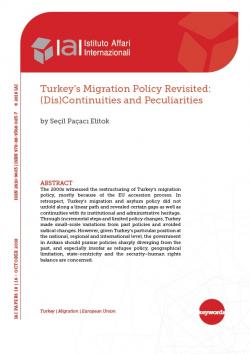Turkey's Migration Policy Revisited: (Dis)Continuities and Peculiarities
The 2000s witnessed the restructuring of Turkey’s migration policy, mostly because of the EU accession process. In retrospect, Turkey’s migration and asylum policy did not unfold along a linear path and revealed certain gaps as well as continuities with its institutional and administrative heritage. Through incremental steps and limited policy changes, Turkey made small-scale variations from past policies and avoided radical changes. However, given Turkey’s particular position at the national, regional and international level, the government in Ankara should pursue policies sharply diverging from the past, and especially insofar as refugee policy, geographical limitation, state-centricity and the security–human rights balance are concerned.
-
Details
Rome, IAI, October 2018, 17 p. -
In:
-
Issue
18|16 -
ISBN/ISSN/DOI:
978-88-9368-083-7
Introduction
1. Continuity with the past
1.1 Ethno-religious nationalism
1.2 Geographical limitation
1.3 “Reforms” as the continuation of 1990s initiatives
2. Discontinuity with the past
2.1 Different responses to mass flows
2.2 Remittance policy
2.3 Turkey’s response to EU progress reports
3. Incremental steps in Turkey’s migration policy
4. The sui generis position of Turkey
Conclusion and policy recommendations
References



